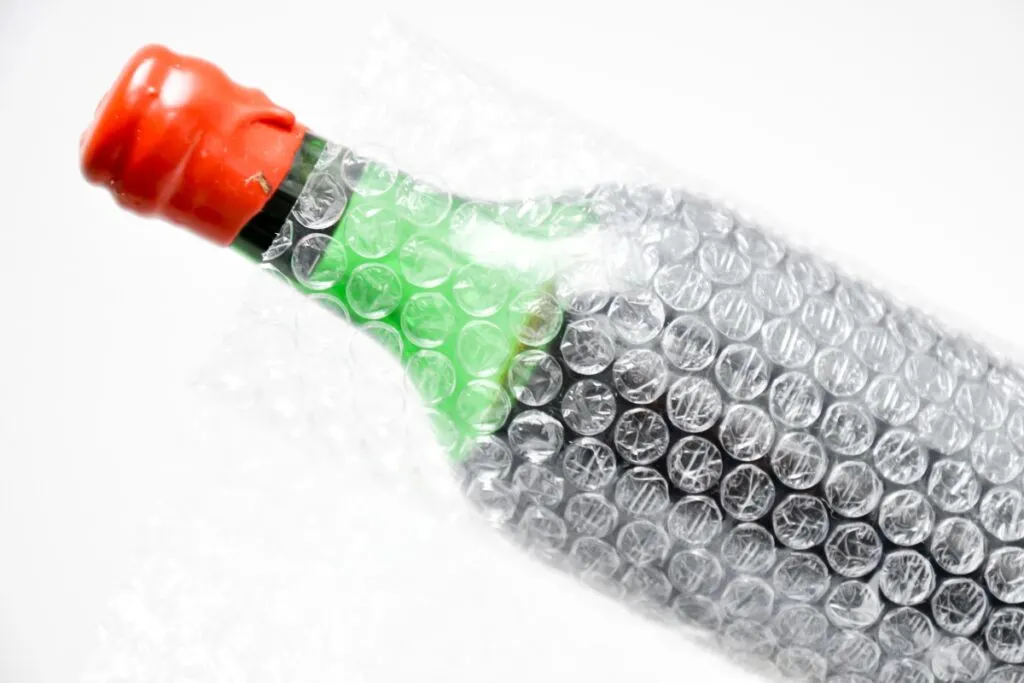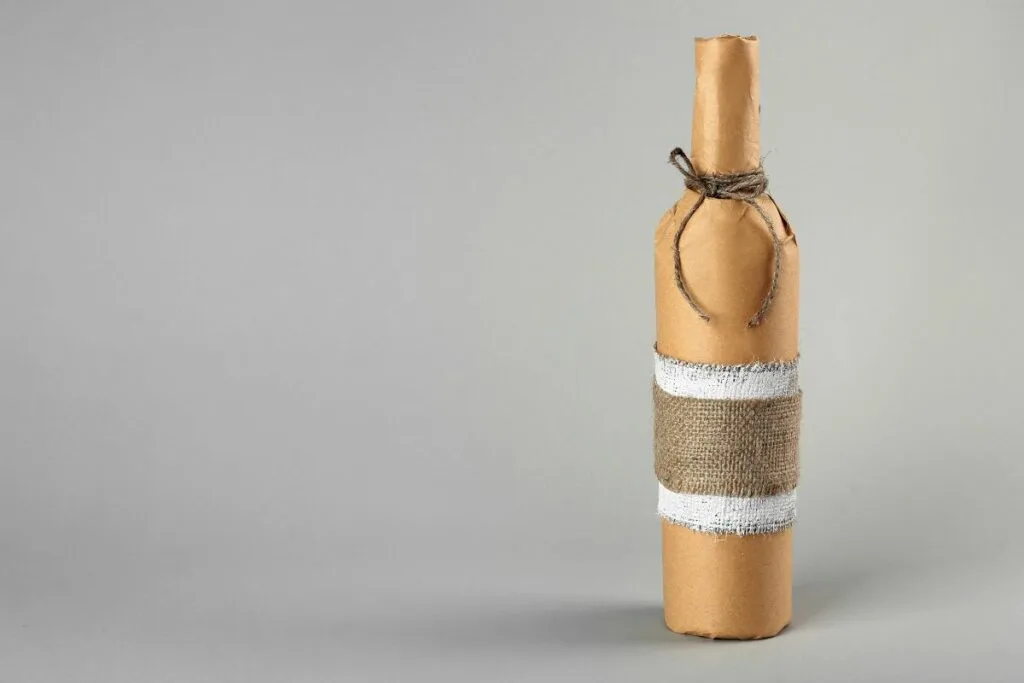As an Amazon Associate, I earn from qualifying purchases with no additional costs for you.
Wine collectors and traders commonly wrap their high-end bottles with plastic wraps, such as Saran Wrap, etc., to protect the labels from scrapes and scuff marks that could significantly reduce their resale value.
In my opinion, there isn’t a downside to wrapping bottles in clear plastic or keeping them wrapped long-term. The Saran Wrap is not expected to stick to the label and cause any damage.
When buying red wine, you may have found that some red wine bottles are covered with a layer of plastic wrap, especially those precious red wines.
As we all know, cling film is a plastic product used for food preservation. So why do you want to wrap a layer of plastic wrap on a wine bottle? What does this do? Read below for the answers.

TIP: If you want to check out the best refrigerator for wine storage, I recommend trying out the Avation (18 bottles) compressor refrigerator with Wi-fi smart app control cooling system. You can find this refrigerator by clicking here (Amazon link).
Why Are Some Wine Bottles Wrapped?
Some wine bottles are wrapped as the plastic wrap will prevent mold or mildew from forming on the label, and it will keep the label physically together with the bottle should the glue disintegrate over time. Wine should be stored long-term in a cool, dark, humid, undisturbed environment.
If some mold or mildew does get through, most wine enthusiasts know that a little mold or mildew on an old bottle is not a bad thing but a sign of proper wine storage.
Recommendation box: Everything you need to enjoy your wine as much as possible. All recommended products are personally tested and regularly used by experts from this website (Amazon links):
> Ivation Wine Cooler – Energy-efficient wine cooler for 18 bottles with Wi-fi smart app control cooling system.
> Wine Rack – Beautiful, elegant wood rack for up to 7 bottles and the choice of vertical or horizontal storage.
> Durand Wine Opener – Classic vintage wine opener (we like all these classic staff).
> YouYah Iceberg Wine Decanter – The most beautiful and handy wine decanter we personally use.
> Bormioli Rocco Wine Glasses – A set of eight elegant and traditional wine glasses made in Italy.
> Vintorio Wine Aerator – Simple but really useful wine aerator for a reasonable price.
> The Original Vacu Vin Wine Saver – The best wine saver on the market in a package with two vacuum stoppers and two wine servers.
And if you want to become a true connoisseur of wine, we recommend reading the book Wine Folly: The Essential Guide to Wine (Amazon link), where you will find all the information you need about winemaking, wine varieties, flavors, and much more.
Another reality is when you are drinking or collecting really expensive wines, the quality of the label does give you some idea of the storage conditions and the care the person took into storing the wine.
It is also interesting to note that there are people who store collectible wines in cellars and wrap each and every one with saran wrap. They do it for two reasons.
One was already mentioned (protect the label from scratches and nicks), but equally important is to avoid wine staining from leaks/breaks/etc. If one were planning to “flip” a bottle of wine (re-sell it), then the people you may want to flip it to may be concerned about nicks/stains/etc.
TIP: To discover if wine fridges are only for storing white wine, check out this complete guide. To discover if wine should come into contact with the cork during wine storage, read this article.
Why Wrap Wine Bottles in Plastic Wrap?
You wrap the wine bottle with plastic wrap mainly to protect the wine label. The wine label is a reflection of the wine, and a damaged wine label is undoubtedly a problematic thing. For dealers, the breakage of the wine label is not only bad for the appearance but also reduces the value of the wine.
Another problem is that it also allows consumers to have little or no understanding of the wine if they cannot read the label.
A wine storage environment requires 60%-70% humidity. The wine inside a wine cellar or wine cabinet that is in a humid environment for too long will become moldy, allowing various mildew spots to appear on the wine label. This is due to moisture damage.
It should be noted that the plastic wrap only needs to tightly wrap the wine label, and the bottle mouth must not be sealed off.
If you have a vapor barrier that always keeps a wine cellar above 70% humidity to protect the corks, then wrapping the bottles in plastic may not work.
If you wrap your bottles in plastic wrap, the condensation that develops inside the plastic would destroy the labels over time and probably result in mold growth between the capsule and cork.
Therefore, if your storage conditions are humid, remove the plastic wrap. The same concept holds for tissue paper.
As far as the kind of plastic wrap, I would suggest not using plastic bags (bulkier does not protect the label as well as saran wrap), and if the plan is to sell the wines, then I would suggest logging all purchases, scanning/logging receipts, tracking a cellar up time/cellar humidity/temperature and be prepared to furnish reports on the above when it comes time to sell the wine. I would imagine having the above will outweigh the nick on the label when it comes to value.
TIP: To learn how to store white wine after opening, check out this article. For a complete breakdown of how to store wine long-term in 8 simple steps, read this guide.
Can You Seal Wine with Plastic Wrap
You can seal wine with plastic wrap. Some people seal wine with plastic when off-site wine storing. If you have a controlled environment and something to store it in, such as old high school lockers to use as storage units, you only need to stack the bottles up and put bubble wrap between the layers.
After a few years, it may become obvious that the labels are being harmed by built-up moisture. However, of course, the wine will not be harmed in any way.
TIP: Most wines go bad once you pop the cork within a day or so. But a Coravin Wine Preservation system (available for a great price on Amazon) can extend the life of your opened wine for weeks or even months. It is awesome. You should check it out to see if it fits your lifestyle.
How to Get Wrapping Off Wine Bottle

It is not hard to get the plastic wrapping off of a wine bottle. Simply unwrap the bottle slowly if you can find where the wrapping began. Then you can un-wrap it by hand with little to no difficulties.
Some people no longer wrap a wine bottle with plastic but instead put the entire bottle in a plastic bag.
A good parallel question is this… if nothing in the outside environment affects a wine’s storage, why is it recommended to store wines in an odorless environment? Aromas must be able to get in through the cork, correct?
The same sentiment holds true for wrapping wine in plastic – outside elements can get through if the bottle is not wrapped.
Many people have never wrapped their wine in plastic. In some areas, it is a rarity, not a commonplace practice. Some believe that the only folks wrapping their wine in plastic are people who have cellars carved into mountainsides where it is extremely humid.
Actually, most of those guys make their own wine, but when they get special bottles, they want to keep those bottles from becoming covered with mold, so they wrap them. An idea of the humidity in some areas… there can be a few inches of mold growing on everything and often dripping water.
So the only way to preserve the labels is to wrap the bottles in plastic wrap. The idea of putting it into a plastic bag is desirable because it is easier than wrapping individually.
TIP: Can wine corks be recycled? find out the complete explanation in this article. If some of your corks are moldy, read this article and find out if the wine inside the bottle is okay.
Conclusion
The bottom line: if you plan to drink the wine (instead of long-term storing it), then you may not really care what the label looks like. If you plan to re-sell it, you may want to figure out another way to prevent labels from coming in contact with anything that could damage them.
TIP: Are you interested in buying a wine stopper? We’ve personally tried and recommend buying one of these wine stoppers (Amazon links):
- The Original Vacu Vin Wine Saver: Our top choice. Very easy-to-use wine stopper/saver. You can enjoy a glass of fresh wine whenever you want without worrying about wasting any.
- EZBASICS Wine Saver: Great alternative to Original Vacu Vin Saver. This wine stopper keeps the flavor of wine for up to one week.
- Champagne Stopper by MiTBA: Wine stoppers for sparkling wines are different. This wine stopper seals your bottle and increases the pressure so your beverage’s bubbles won’t go to waste.
You can store bottles in Styrofoam containers, put each bottle in a sock, or use plastic net sleeves. But if all else fails, you can always wrap them in plastic!
TIP: Check out this page for a complete list of wine products and accessories I love. You’ll find my recommendations for wine refrigerators, decanters, and aerators and the best place to buy wine online. Click here to see the complete listing.
